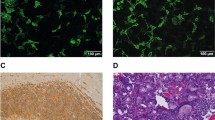Abstract
We report on a 6-year-old boy with chronic granulomatous disease (CGD) complicated by chronic inflammatory reactions with formation of large pulmonary granuloma as well as intracerebral lesions. Bone marrow transplantation (BMT) from an unrelated donor led to stable reconstitution, to rapid resolution of pulmonary granuloma, and to rapid resolution of intracerebral lesions.


Similar content being viewed by others
Abbreviations
- BMT:
-
bone marrow transplantation
- CGD:
-
chronic granulomatous disease
- CT:
-
computer tomography
- gp91phox :
-
glycoprotein-91-phosphatase
- GvHD:
-
graft-versus-host disease
- MRI:
-
magnetic resonance imaging
References
Agus S, Spektor S, Israel Z (2000) CNS granulomatosis in a child with chronic granulomatous disease. Br J Neurosurg 14:59–61
Alsultan A, Williams MS, Lubner S, Goldman FD (2006) Chronic granulomatous disease presenting with disseminated intracranial aspergillosis. Pediatr Blood Cancer 47:107–110
Brown JR, Goldblatt D, Buddle J, Morton L, Thrasher AJ (2003) Diminished production of anti-inflammatory mediators during neutrophil apoptosis and macrophage phagocytosis in chronic granulomatous disease (CGD). J Leukoc Biol 73:591–599
Fleischmann J, Church JA, Lehrer RI (1986) Primary Candida meningitis and chronic granulomatous disease. Am J Med Sci 291:334–341
Foster CB, Lehrnbecher T, Mol F, Steinberg SM, Venzon DJ, Walsh TJ, Noack D, Rae J, Winkelstein JA, Curnutte JT, Chanock SJ (1998) Host defense molecule polymorphisms influence the risk for immune-mediated complications in chronic granulomatous disease. J Clin Invest 102:2146–2155
Gardai S, Whitlock BB, Helgason C, Ambruso D, Fadok V, Bratton D, Henson PM (2002) Activation of SHIP by NADPH oxidase-stimulated Lyn leads to enhanced apoptosis in neutrophils. J Biol Chem 277:5236–5246
Goldblatt D (2002) Current treatment options for chronic granulomatous disease. Expert Opin Pharmacother 3:857–863
Hadfield MG, Ghatak NR, Laine FJ, Myer EC, Massie FS, Kramer WM (1991) Brain lesions in chronic granulomatous disease. Acta Neuropathol (Berl) 81:467–470
Kasahara Y, Iwai K, Yachie A, Ohta K, Konno A, Seki H, Miyawaki T, Taniguchi N (1997) Involvement of reactive oxygen intermediates in spontaneous and CD95 (Fas/APO-1)-mediated apoptosis of neutrophils. Blood 89:1748–1753
Lekstrom-Himes JA, Kuhns DB, Alvord WG, Gallin JI (2005) Inhibition of human neutrophil IL-8 production by hydrogen peroxide and dysregulation in chronic granulomatous disease. J Immunol 174:411–417
Liese J, Kloos S, Jendrossek V, Petropoulou T, Wintergerst U, Notheis G, Gahr M, Belohradsky BH (2000) Long-term follow-up and outcome of 39 patients with chronic granulomatous disease. J Pediatr 137:687–693
Meischl C, Roos D (1998) The molecular basis of chronic granulomatous disease. Springer Semin Immunopathol 19:417–434
Roesler J, Heyden S, Burdelski M, Schafer H, Kreth HW, Lehmann R, Paul D, Marzahn J, Gahr M, Rosen-Wolff A (1999) Uncommon missense and splice mutations and resulting biochemical phenotypes in German patients with X-linked chronic granulomatous disease. Exp Hematol 27:505–511
Roesler J, Koch A, Porksen G, von Bernuth H, Brenner S, Hahn G, Fischer R, Lorenz N, Gahr M, Rosen-Wolff A (2005) Benefit assessment of preventive medical check-ups in patients suffering from chronic granulomatous disease (CGD). J Eval Clin Pract 11:513–521
Segal BH, Leto TL, Gallin JI, Malech HL, Holland SM (2000) Genetic, biochemical, and clinical features of chronic granulomatous disease. Medicine (Baltimore) 79:170–200
Seger RA, Gungor T, Belohradsky BH, Blanche S, Bordigoni P, Di Bartolomeo P, Flood T, Landais P, Muller S, Ozsahin H, Passwell JH, Porta F, Slavin S, Wulffraat N, Zintl F, Nagler A, Cant A, Fischer A (2002) Treatment of chronic granulomatous disease with myeloablative conditioning and an unmodified hemopoietic allograft: a survey of the European experience, 1985–2000. Blood 100:4344–50
von Bernuth H, Knoechel B, Bergert R, Winkler U, Wendisch J, Hahn G, Rupprecht E, Roesler J, Gahr M (2003) Clinical presentation, diagnosis and therapy of granulomatous inflammations in patients with chronic granulomatous disease (CGD). Monatsschr Kinderheilkd 151:49–56
Winkelstein JA, Marino MC, Johnston RB Jr, Boyle J, Curnutte J, Gallin JI, Malech HL, Holland SM, Ochs H, Quie P, Buckley RH, Foster CB, Chanock SJ, Dickler H (2000) Chronic granulomatous disease. Report on a national registry of 368 patients. Medicine (Baltimore) 79:155–169
Author information
Authors and Affiliations
Corresponding author
Rights and permissions
About this article
Cite this article
Schuetz, C., Hoenig, M., Schulz, A. et al. Successful unrelated bone marrow transplantation in a child with chronic granulomatous disease complicated by pulmonary and cerebral granuloma formation. Eur J Pediatr 166, 785–788 (2007). https://doi.org/10.1007/s00431-006-0317-7
Received:
Revised:
Accepted:
Published:
Issue Date:
DOI: https://doi.org/10.1007/s00431-006-0317-7




